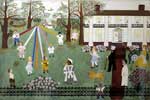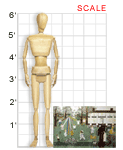From the collection of:
Behringer-Crawford Museum || VAM Home
Mary Bruce Sharon (American, 1877-1961)
MY MAYPOLE PARTY, c. 1950s
Gouache on cardboard; 20" X 30"
From the Eva G. Farris Collection of the Behringer-Crawford Museum
This work portrays a May Day party thrown for Mary Bruce Sharon when she was 9 years old by her great-aunt in Flemingsburg, Kentucky. It shows an exterior scene of a white Colonial-style house with a gazebo. Children play in the yard and dance around a Maypole. A few adults watch the festivities, and a maid helps with the children.
About the Artist
Mary Bruce Sharon moved to Covington, Kentucky, after the death of her father in 1880. Under the care of her wealthy grandfather, Col. Henry Bruce (a Confederate sympathizer and businessman who helped hire John Roebling to design and build the famous suspension bridge that crosses the Ohio River between Covington and Cincinnati), she led a privileged life there. She had her own playroom equipped with working appliances; met famous people like Sitting Bull, Tom Thumb, and Buffalo Bill; and traveled with her family to New York City for part of each year. Mary visited the Metropolitan Museum of Art for the first time when she was 7. Both her mother and grandfather collected art.
Mary wed Fredrick Christy Sharon, and the couple spent the early years of their marriage in Kansas City. They had one child, Henrietta. The Sharons moved to New York in 1939 and then to Connecticut. After her husband died in 1944, Mary went to live with her daughter.
At the age of 71, Sharon (known as “Mouse” to her friends) took up painting at the suggestion of her son-in-law, abstract painter Carroll Aument. She continued until her death in 1961, completing 150 paintings in 13 years. She worked mostly in gouache—a heavy, opaque watercolor paint that produces a drier-looking and more strongly colored result than ordinary watercolor.
Most of Sharon’s paintings depict scenes from her early childhood. Her artwork was influenced by such themes as her childhood in Covington, the Ohio and Licking rivers, and the Kentucky Derby. The clothing, architecture, and furnishings she painted offer a glimpse into the world of a wealthy child in the late 1800s, including popular activities and family traditions. Sharon also painted scenes of New York City as well as others inspired by stories from her grandfather’s and great-grandparents’ lives.
Sharon’s paintings were exhibited at the Taft Museum in Cincinnati and at the Metropolitan Museum of Art in New York City. Her works also have been included in a Smithsonian Institution traveling exhibit and in a book she wrote, Scenes from Childhood.
Classroom Ideas
Discussion: Describe all the things you see in this painting. How many buildings are shown? How many people? What different kinds of things are the people doing? What else is in the yard? What period in time do you think this work depicts? Why? What is the focal point of the painting? Do you know what a May Day party is? What visual elements tell you that the painting shows a spring scene? What feeling does this painting convey? How does the artist’s use of the elements of art help convey this feeling? Do you think that Mary Bruce Sharon’s memories of her childhood were happy?
Activities: Research May Day and the Maypole and plan a May Day celebration for your class.
Choose an event you remember from your childhood and paint it.
Links
Read about May Day celebrations and learn how to make a tabletop Maypole at About.com’s Celebrating May Day page.
[familycrafts.about.com/cs/mayholidays/a/aa041700a.htm]
The abcteach site includes a Maypole coloring page.
[www.abcteach.com/Activities/maypole.htm]



